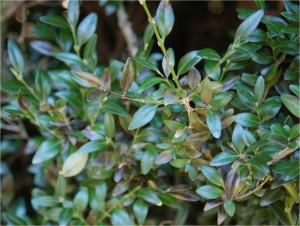Boxwood blight is a disease caused by a fungus (Cylindrocladium pseudonaviculatum) which is a serious threat to most boxwood (Buxus) and related species such as sweetbox (Sarcococca spp.). To date there is no evidence of resistance to boxwood blight in any Buxus species.
Plant pathologists in England first identified the disease in the mid-1990’s. It was first detected in the United States in North Carolina and Ohio in late 2011. The disease is now confirmed in 8 additional states (CT, MA, MD, NY, OR, PA, RI, VA) and in British Columbia.
Initial symptoms of boxwood blight include leaf spotting, rapid leaf drop, blackened stem cankers, and severe dieback. Most boxwoods are not immediately killed by the disease, but the plant(s) will become badly defoliated and unsightly.
Boxwood blight is spread primarily by water (rain splash, irrigation, runoff, etc.), by sale or exchange of plants in the nursery/garden center trade, and through contaminated tools, equipment, boots, etc. The sticky spores infect pruners and other tools, clothing, tires, and, of course, boxwood leaves.
Disease spread is rapid, often in less than a week if weather is warm and humid. The disease is carried by splashing or wind driven rain. At this time there is no cure for boxwood blight. Here are some key steps for gardeners and landscapers to follow:
- Know the primary symptoms of boxwood blight and check boxwoods in the garden regularly
- Before purchasing inspect boxwoods at garden centers, and reject any with yellow spotted leaves and black stem cankers
- During pruning, dip clippers into a 1-to-10 ratio of bleach to water or 70 percent ethanol solution for 1-2 minutes before moving on to a new plant.
- Properly dispose of all diseased plants or clippings; do not compost them
- Limit buying of new boxwoods and avoid combining new with existing plants
- Take suspect boxwood plants and clippings to a county Extension office or to a full service retail garden center for proper diagnosis.


 Posted in
Posted in 
